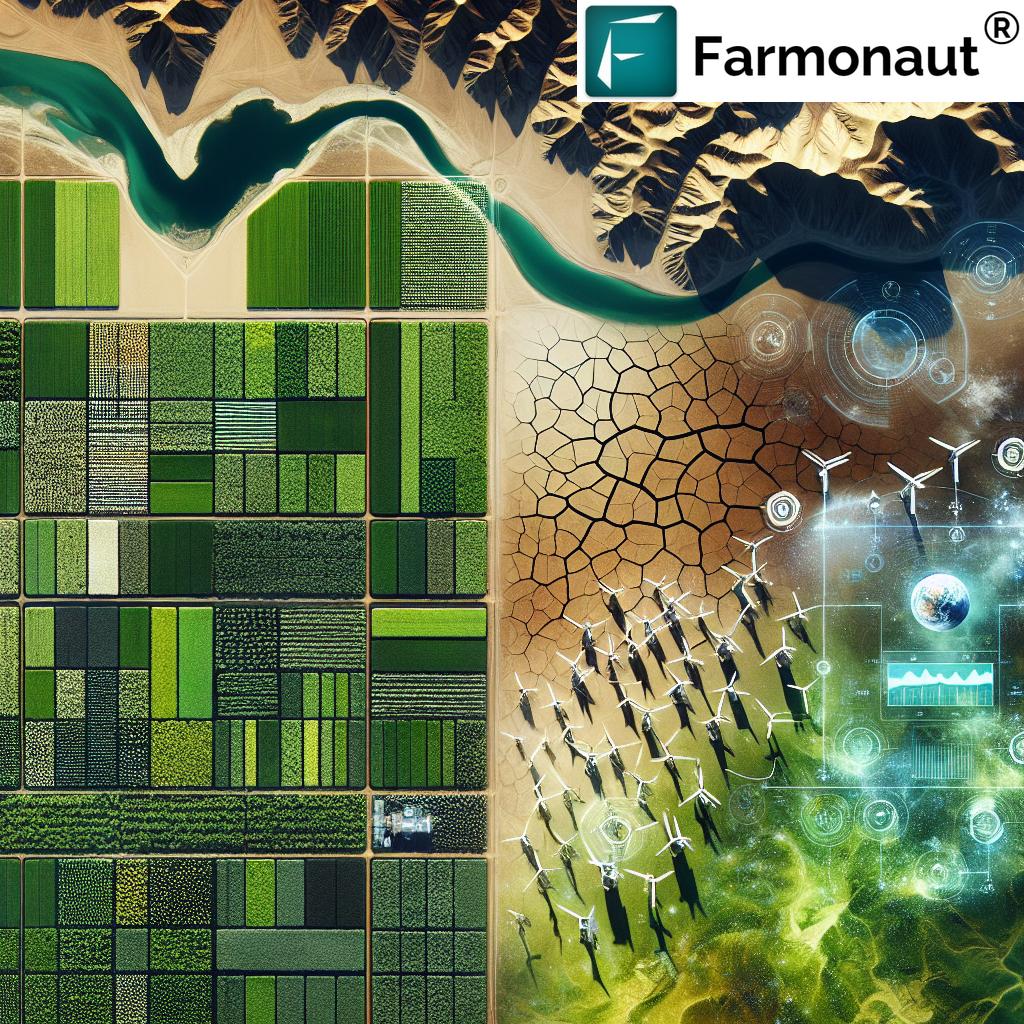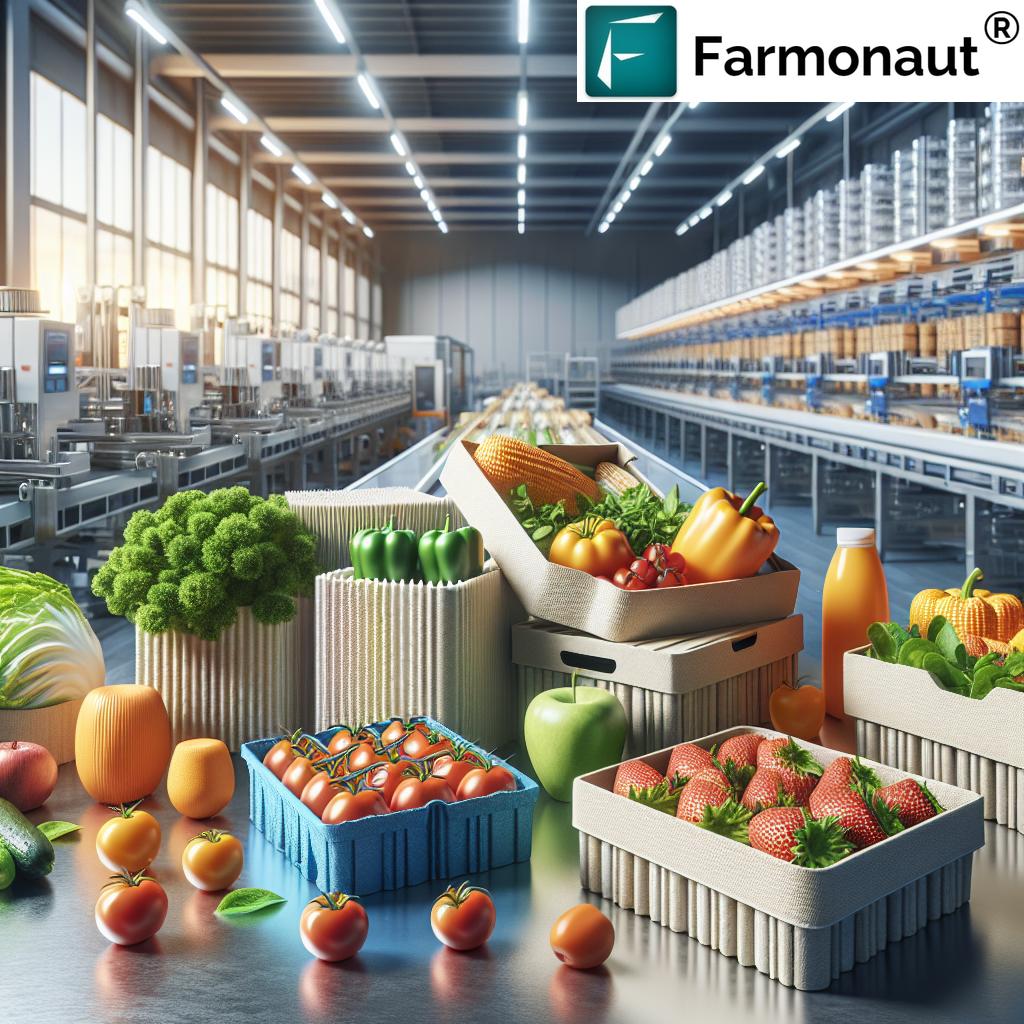“One acre of sustainable farming can sequester up to 2.5 metric tons of CO₂ annually, generating valuable carbon credits.”
Carbon Credits for Farmers: Earn More & Save the Planet! | A Comprehensive Overview
As our global community intensifies efforts to combat climate change, agriculture stands as a critical sector for reducing greenhouse gas emissions and promoting carbon sequestration. In this comprehensive overview, we’ll explore how carbon credits for farmers create compelling opportunities: from increasing income and supporting farm resilience to driving tangible climate change mitigation in agriculture.
We’ll unpack the mechanisms behind agricultural carbon markets, best-in-class sustainable farming practices, the process of carbon credit certification and verification, and the transformative power of innovative technologies like Farmonaut. Whether you’re a farmer seeking diversified revenue or simply want to understand how soil carbon storage helps save the planet,
you’ll find actionable insights here.
Let’s dive in to discover how farmers worldwide can generate carbon credits, boost profitability, and participate in climate solutions.
Understanding Carbon Credits in Agriculture
To fully appreciate the value of carbon credits for farmers, we must start with the fundamentals: What are carbon credits?
What Are Carbon Credits?
Carbon credits are tradable certificates that represent the removal or prevention of one metric ton of carbon dioxide (CO₂)—or its equivalent in other greenhouse gases—from entering the atmosphere. These units of measurement are generated by projects that reduce, avoid, or sequester greenhouse gas emissions.
Within agriculture, these projects typically involve activities that:
- Increase soil carbon—by adding organic matter and reducing soil disturbance, thus promoting soil carbon storage
- Reduce emissions—from on-farm activities and livestock operations
- Remove carbon—from the atmosphere (carbon sequestration in agriculture)
Why Are Carbon Credits Important for Farmers?
Farmers are uniquely positioned to both mitigate climate change and increase their income:
- By adopting sustainable practices, they generate carbon credits while also improving soil health and farm resilience
- These credits create a revenue stream in carbon markets, where businesses and governments buy certificates to offset emissions and meet climate goals
- This linkage between climate action and farm profitability offers a win-win for producers and the planet
A Simple Example of a Carbon Credit in Action
If we convert conventional plowed land to no-till, we might increase soil organic carbon by 1 ton per hectare per year. For each metric ton of CO₂ sequestered, the farmer receives one carbon credit — which can be sold in voluntary or compliance markets, converting sustainability into profits.
How Do Farmers Earn Carbon Credits?
Farmers can generate these credits by implementing sustainable farming practices that either
reduce emissions or enhance carbon sequestration in their fields, pastures, or orchards.
- Reduce: Switching to fertilizer methods that lower nitrous oxide emissions
- Avoid: Eliminating or minimizing tillage to avoid releasing stored CO₂ back into the atmosphere
- Sequester: Integrating cover crops or agroforestry to increase long-term carbon storage
Through certification and verification processes, these activities are quantified and converted into marketable carbon credits.
“Global carbon credit market for agriculture is projected to reach $20 billion by 2030, rewarding eco-friendly farmers.”
Best Agricultural Practices for Generating Carbon Credits
Let’s explore the most impactful sustainable farming practices that can generate carbon credits, increase on-farm carbon sequestration, and reduce greenhouse gas emissions in agriculture:
-
No-Till or Reduced Tillage:
- By avoiding tillage and reducing soil disturbance, we increase soil organic matter and enhance carbon sequestration (learn more).
-
Cover Cropping:
- Planting cover crops during fallow periods prevents erosion, improves soil structure, and boosts soil carbon storage by capturing atmospheric CO₂ (details).
-
Agroforestry:
- Integrating trees and shrubs into croplands diversifies income, supports biodiversity, and actively sequesters carbon (explore).
-
Improved Manure Management:
- Optimizing manure storage and field application significantly reduces methane emissions, enriches soil fertility, and offers emissions reductions from livestock.
-
Precision Agriculture:
- Utilizing data and technology to apply fertilizers and water with pinpoint accuracy minimizes emissions, reduces waste, and can maximize crop yields.
- Farmonaut’s Platform provides satellite-based carbon footprinting, helping us monitor emissions and optimize sustainable practices cost-effectively.
-
Rotational Grazing and Livestock Management:
- Managing grazing cycles and pasture quality reduces overgrazing, builds resilient soils, and supports on-farm carbon storage.
-
Biochar Application:
- Applying stable biochar to soils locks away carbon for decades, increasing both fertility and long-term sequestration.
Each practice not only increases carbon sequestration in agriculture but also delivers additional benefits, including improved soil health, increased biodiversity, and enhanced resilience to climate change.
Comparison Table of Sustainable Farming Practices and Estimated Carbon Credit Earnings
This table highlights the potential income from carbon credits for several sustainable farming techniques, the amount of CO₂ removal, and the added environmental impacts. Understanding these can guide our choice of methods and forecast revenue streams.
| Sustainable Practice | Estimated CO₂ Sequestered (tons/hectare/year) | Estimated Carbon Credits Earned (USD/year) | Additional Environmental Benefits |
|---|---|---|---|
| No-Till/Reduced Tillage | 1.0-1.5 | $18 – $45 | Reduces erosion, improves water retention, increases organic matter |
| Cover Cropping | 0.8–1.2 | $15 – $36 | Improves microbial activity, reduces nutrient loss |
| Agroforestry | 2–8 | $40 – $192 | Enhances biodiversity, shade, and wind protection |
| Improved Manure Management | 0.5–1.0 | $9 – $24 | Reduces methane, improves soil nutrients |
| Biochar Application | 2.5–5.0 | $50 – $120 | Long-term carbon storage, enhances soil fertility |
*Estimates based on average global carbon prices (2023–2024, voluntary markets, $18–$24 per ton CO₂). Actual earnings vary by region, practice implementation, and market demand.
Carbon Credit Certification and Verification
Ensuring the integrity and market acceptance of credits depends on robust certification and verification standards. These processes ensure that claimed emission reductions are real, measurable, additional, and permanent.
How Does Certification Work?
-
Adopt Approved Methodologies:
- Verified Carbon Standard (VCS): Methodologies such as the VCS guide how to quantify, monitor, and report carbon outcomes in farming.
-
Rigorous Monitoring and Reporting:
- We must track soil carbon changes, emission reductions, and relevant farm operations with transparency — using data, photographs, field logs, and more. Farmonaut’s satellite-based monitoring tools enhance accuracy and reduce reporting costs.
-
Third-Party Verification:
- Independent auditors vet the data and methodology to ensure all climate benefits are robust, avoid double-counting, and meet global carbon market requirements.
-
Issuing Certificates:
- Once approved, the credits are issued as tradable certificates which can be offered in voluntary or compliance markets.
What Are the Major Certification Standards?
-
Verified Carbon Standard (VCS) by Verra
- Widely accepted in voluntary markets for projects including soil carbon, methane reductions, and sustainable agriculture.
-
Gold Standard
- Focuses on high social and environmental co-benefits. Suited for smaller or more innovative on-farm projects.
-
Climate Action Reserve (CAR)
- Prominent in the United States; provides stringent criteria for soil and manure management.
What Role Does Technology Play in Certification?
Accurate data collection is the basis for credible carbon credit generation. This is where Farmonaut’s advanced technology is a game-changer. Their satellite and AI-driven systems offer farmers:
- Real-time, affordable crop monitoring
- Automated, tamper-proof reporting (using blockchain-based product traceability — learn how Farmonaut’s traceability works)
- Compliance with evolving monitoring, reporting, and verification (MRV) requirements in global carbon markets
Market Dynamics and Revenue Potential for Agricultural Carbon Credits
The agricultural carbon market is evolving rapidly. Between 2019 and 2022, the volume of voluntary credits from agriculture increased 125% (EDF Source). Major corporations, governments, and even tech leaders are now actively investing in carbon credits for farmers (see: Google deal in India).
What Determines Carbon Credit Prices?
- Market Demand: As more organizations set climate goals, demand is forecasted to rise—even reaching $20 billion by 2030 for agriculture alone.
- Credit Quality: Factors include certification level (e.g. Gold Standard), permanence, and co-benefits (like biodiversity).
- Scale: Large, aggregated projects or those partnering with technology platforms like Farmonaut may benefit from lower certification costs and higher per-credit value.
Typical prices range from $15 to $24 per ton of CO₂ removed, with future increases likely as climate action accelerates.
How Are Carbon Credits Sold and Monetized?
- Voluntary Carbon Markets: Corporations purchase credits to offset emissions outside regulatory requirements, favoring projects with social and environmental impacts.
- Compliance Markets: Regulated sectors (like power or industry) are mandated to offset emissions—potentially expanding to agriculture.
- Direct Sales: Platforms connect farmers and smallholders with buyers, often enabling “grouped projects” for lower entry barriers.
For streamlined entry into these markets, Farmonaut’s large-scale farm management platform enables grouping and monitoring at a regional level.
Key Challenges and Considerations for Farmers
While the potential is significant, carbon farming initiatives face several important challenges. Understanding these issues helps us make informed choices and maximize the benefits.
- Additionality:
Credits must come from new emission reductions—not changes that would have happened regardless. Transparent monitoring, reporting, and verification is vital (read more). - Permanence:
Stored carbon should remain for decades; contracts and methodologies must account for reversal risks (for example, due to plowing or fire). - Verification Costs:
Certification and measurement can be expensive, especially for smaller farms. Platforms using satellite and AI (like Farmonaut) help reduce these costs by providing real-time carbon footprinting. - Market Volatility:
Carbon credit prices fluctuate, making income streams unpredictable. - Complex Regulations:
Different markets, regions, and buyers have varying criteria for credits. Staying updated is crucial. - Data Integrity and Fraud:
Maintaining the reliability of reporting is best accomplished via blockchain-based traceability and third-party verification.
Despite these hurdles, advances in technology and supportive programs are lowering entry barriers for farmers.
Initiatives and Support for Farmers
To address the above challenges, organizations and governments are launching new initiatives for carbon farming:
- ACORN (Rabobank): Combines remote sensing with simplified MRV to help smallholders access carbon markets.
- Indigo Ag’s Carbon Program: Returns up to 75% of generated credits’ value to farmers, boosting the revenue incentive (see how).
- Government Grants and Public-Private Programs: For example, in the U.S., recent investments are helping small forest landowners participate (news link).
- Innovative Monitoring Platforms: Digital systems like Farmonaut’s satellite API empower developers, research institutes, and farmers to track, verify, and optimize carbon sequestration and emissions reductions.
For detailed weather tracking, land-use analytics, and advisory integration, API developer docs are available here.
Farmonaut: Technology for Sustainable, Profitable Carbon Farming
At Farmonaut, we are committed to democratizing access to precision agriculture and leveraging technology to empower farmers globally—regardless of scale or location.
How Does Farmonaut Support Carbon Credit Generation?
-
Satellite-Based Crop Health and Soil Monitoring:
- We utilize multispectral satellite imagery to monitor vegetation health (NDVI), soil moisture, and key metrics that underpin MRV requirements for carbon credit verification. This approach eliminates guesswork and reduces on-the-ground measurement costs.
- Farmonaut enables real-time crop health monitoring, helping users instantly spot problems, optimize irrigation, and ensure long-term soil carbon storage.
-
AI and Jeevn Advisory:
- Our Jeevn AI system delivers real-time, personalized guidance based on farm-specific data. Accurate advisory systems help maximize carbon credit eligibility and yield-related sustainability outcomes.
-
Blockchain-Based Traceability:
- Every major step across supply chains is recorded in an immutable, tamper-proof ledger for regulatory compliance, certification, and buyer confidence.
-
Fleet and Resource Management:
- Efficient machinery use reduces emissions, conserves fuel, and supports sustainable logistics. Explore fleet management solutions that reduce both costs and carbon footprint.
-
Carbon Footprinting and Real-Time Monitoring:
- With Farmonaut’s carbon footprinting tool (learn more), agribusinesses and farmers can assess their current emissions, track progress, and showcase data to carbon buyers—all from their phone or browser.
Why Use Farmonaut for Carbon Farming?
- Affordability and Accessibility: We use satellite data (no expensive hardware needed), bringing carbon farming within reach for any farm size.
- Accuracy and Integrity: Our AI- and blockchain-backed systems mean transparent reporting and verifiable credits.
- Multi-Platform Access: Manage your farm via web, Android, iOS, or integrate Farmonaut’s API into your preferred agri-software stack.
- Support Across the Value Chain: From field to harvest, and even through financing (with satellite-based loan & insurance verification), Farmonaut simplifies the entire process.
By integrating Farmonaut into your operations, our farmers and agribusinesses can unlock additional income from carbon credits, demonstrate sustainable farming practices to buyers and regulators, and future-proof their operations.
Recent Developments in Agricultural Carbon Credits
-
Rewarding farmers for regenerative agriculture is ‘critical for decarbonising the food sector’
— Highlighting the urgency and opportunity for carbon farming in food supply chains. -
Boomitra
— A significant player using digital MRV for scaling soil carbon programs globally. -
Google signs deal to buy carbon removal credits from Indian farms
— Demonstrating the growing corporate demand and validation of the agricultural carbon credit sector.
Future Outlook: Expanding the Role of Carbon Credits in Agriculture
As carbon markets mature and climate regulation increases, the demand for agricultural credits will likely accelerate. Here’s how we see the future:
- Continued Growth: Projected at $20 billion by 2030, thanks to tighter regulations, global corporate action, and growing consumer demand for sustainable products.
- Refined Methodologies: Ongoing updates to MRV protocols and scientific research will expand credit eligibility and reduce verification costs, especially for smallholders.
- Digital Innovation: Platforms leveraging satellite and AI-based monitoring will become standard, lessening fraud and lowering operational barriers.
- Integrated Ecosystem Services: Future credits may bundle climate, water, biodiversity, and social impacts, capturing the full value of sustainable farming practices.
- Farmer Empowerment: Market developments and tools like Farmonaut’s platform will democratize access, making carbon credits for farmers a mainstream revenue stream rather than a niche opportunity.
By keeping pace with technology and market trends, our agricultural community can play a pivotal role in climate change mitigation—while enhancing profitability and resilience for generations to come.
Frequently Asked Questions: Carbon Credits for Farmers
1. What are carbon credits, and why should farmers care?
Carbon credits are certificates representing the removal or prevention of one metric ton of CO₂ (or equivalent greenhouse gases) from the atmosphere. By generating carbon credits through sustainable practices, farmers can create new sources of income while contributing to global efforts to combat climate change.
2. How does a farmer get started with carbon credit markets?
Begin by adopting eligible sustainable farming practices (like reduced tillage or cover cropping), collect robust monitoring data (using tools like Farmonaut’s platform), and connect with a recognized certification body (such as VCS or Gold Standard). Technology-driven platforms can simplify MRV, certification, and eventual sale of credits.
3. Are small-scale farmers eligible?
Yes! Many digital initiatives (including Farmonaut) support smallholder access. Grouped or aggregated projects make certification and monitoring cost-effective for farms of any size.
4. What determines the value of a carbon credit?
The price of a carbon credit depends on the amount of CO₂ removed, the certification standard, co-benefits (like biodiversity or water), and real-time market demand. Strong reporting and high-integrity credits—especially those with digital verification—usually fetch higher prices.
5. What are the main costs involved in generating carbon credits?
Primary costs include practice implementation (like seed or technology purchases), monitoring and reporting (simplified by satellite/AI platforms), and certification (which can be shared through grouped projects). Farmonaut’s digital solutions help minimize these expenses through automation.
Conclusion: Empowering Farmers to Lead Climate Solutions
Carbon credits for farmers represent a transformative synergy between sustainable agriculture, economic opportunity, and global climate goals. By adopting science-backed practices, leveraging digital solutions (like those from Farmonaut), and engaging in robust carbon credit certification and verification processes,
our community can:
- Generate marketable carbon credits from everyday farming activities
- Boost on-farm income and financial resilience
- Enhance soil health, biodiversity, and resource efficiency across diverse geographies
- Support the global transition towards sustainable food systems
Whether you cultivate a single hectare or manage vast agribusinesses, the tools and strategies discussed here—backed by advanced technology and forward-thinking programs—put climate change mitigation in agriculture within everyone’s reach.
Join us on the journey to a greener, more profitable future—with Farmonaut at your side.
Farmonaut Subscription Plans
Ready to get started? Explore Farmonaut’s affordable, scalable packages for precision farm management—from individual fields to regional projects. Choose the plan that fits your needs and unlock actionable climate and productivity insights right from your phone or PC!
“Unlock new income streams, safeguard our planet’s climate, and lead the sustainable agriculture revolution—with carbon credits for farmers, Farmonaut, and our global community!”













